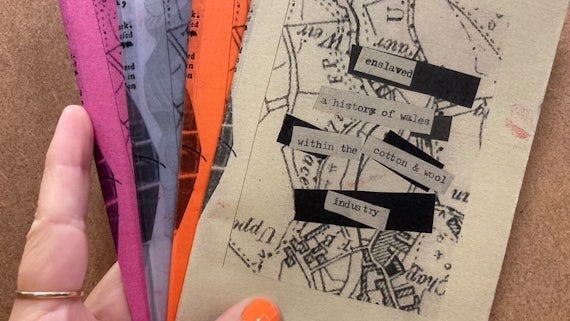Woven Histories of Welsh Wool and Slavery
5 July 2023

The global significance of Welsh-made woollens in the Atlantic slave trade is the subject of a research project led by a Cardiff University academic.
Dr Charlotte Hammond collaborated with student artists from Coleg Menai in Bangor, Liz Millman of Learning Links International and Marcia Dunkley of Black Heritage Walks Network, to investigate this overlooked period of Wales’ history. It has been supported by Higher Education Funding Council for Wales (HEFCW) Research Innovation Funding.
Welsh Plains was a durable ‘plain’ woollen cloth, woven in mid-Wales between 1650-1850.
Before it was eventually overtaken by cotton, wool was at the centre of the global textile industry of the eighteenth century. British merchants used the cloth to purchase and trade in African captives, kidnapped to work on plantations in the Americas in the transatlantic slave trade. Plantation owners in the Caribbean and US South used the hand woven woollen textile to clothe enslaved labourers.
In the eighteenth and early nineteenth century, Welsh Plains became a popular textile for the jackets, waistcoats, smocks, petticoats and breaches worn by enslaved men, women and children in the Americas. In 1823, the South Carolina planter, Robert Maxwell, wrote that local manufacturers had tried to imitate Welsh Plains but found its qualities to be inferior. Maxwell preferred to buy cloth that had been “made by the farmers of Wales”.
The research project and free bilingual book of the same name, Woven Histories of Welsh Wool and Slavery / Hanesion Cysylltiedig Gwlân Cymru a Chaethwasiaeth, published by Common Threads Press, aims to improve public knowledge of the ways local histories of woollen production in Wales are implicated in broader global histories of Atlantic slavery and empire.
Dr Charlotte Hammond, based at Cardiff University’s School of Modern Languages said: “With this project, we have sought to highlight an area of history that has received little recognition until now.
“The students explored traces of this historical narrative that links the exploitation of weavers in rural Wales with the racial injustices of Atlantic slavery, and its reliance on the circulation of Welsh-made textiles.
“Our work has taken us from the ruins of pandy fulling mills in Dolgellau, Meirionnydd, via the packhorse trails that transported Welsh Plains cloth to England. There, it was dyed and finished in Shrewsbury, sent to London and Liverpool to be traded and then exported to the Americas.
“We have followed the cloth’s colonial connections to the Caribbean and southern states of the US, where Welsh Plains was used to clothe enslaved field workers who toiled on the plantations.
“We traced a small swatch of ‘plains’ which is listed in a merchant’s sample book (c.1800-1825) in the Joseph Downs Collection in the Winterthur Library, Delaware (US). This remnant shows the fabric to be coarse and probably quite uncomfortable to wear, a far cry from the expensive silks and linens worn by the plantation owners.
“The resulting artwork from the group of emerging artists and designers is their visual response to this history.”
Anne Butler, a student involved in the project said: “It was fascinating to find out the connection between these old forgotten mills, many of which are now being reclaimed by nature, and their part in the production of wool that was used to clothe enslaved people across the Atlantic. I think it is important to shed light on this history.
“The project brought up some strong feelings which could be channelled into our art.”
Community researcher Liz Millman , who led the 2019 National Lottery Heritage-funded project ‘From Sheep to Sugar’ said: “It’s incredibly hard to find any woollen cloth of that time. Woollen cloth is particularly vulnerable to being eaten by moths. Plantation work clothes were also less likely to have been preserved than finer clothes such as silk dresses.
“We worked with the spinners, weavers, and dyers guilds and tried to understand the whole process of how the cloth was made, and the most exciting news lately is that we’ve recently found a tiny example of Penistone woollen cloth. We asked a specialist weaver Jo Andrews who records the Haptic and Hue podcast, to check it out and it is exciting.”
Historian and Educator Marcia Dunkley said: “We need to connect the story of Welsh wool to the Caribbean and continue to explore the memory of Welsh Plains from an Atlantic perspective if we are to address this incomplete history. Have people still got remnants of this cloth? How is it remembered in the Caribbean?”
Dr Hammond added: “This is slow work that needs to be enacted across multiple platforms, via the new Curriculum for Wales, and within cultural and heritage institutions.
“The de-colonial work of interrogating this past and its enduring legacies is an ongoing process that requires long-term commitment across multiple sectors.”
Student work relating to the project has also been exhibited at Cardiff University. In partnership with Elin Angharad of Llyfrgell Zine Cymru, a group of Art and Design Foundation students from Coleg Menai each created their own small zine, which will be showcased in the book and free to access online.
The zines they produced reclaim diverse printed material from the archives to reframe the dominant narrative of mill or plantation scenes authored by European travellers. Using the theme of zine-making as marronage – the act of escaping the plantation – the students used creative research methods – drawing, cutting, collaging images and text and assembling new narratives – as a form of alternative knowledge production regarding this silenced history.
Dr Hammond added: “We are grateful to all students who took part in the project and for their thoughtful responses to a period of Welsh history that has received little attention until now.”
Content warning: this book contains colonial racial language that is considered offensive today.




